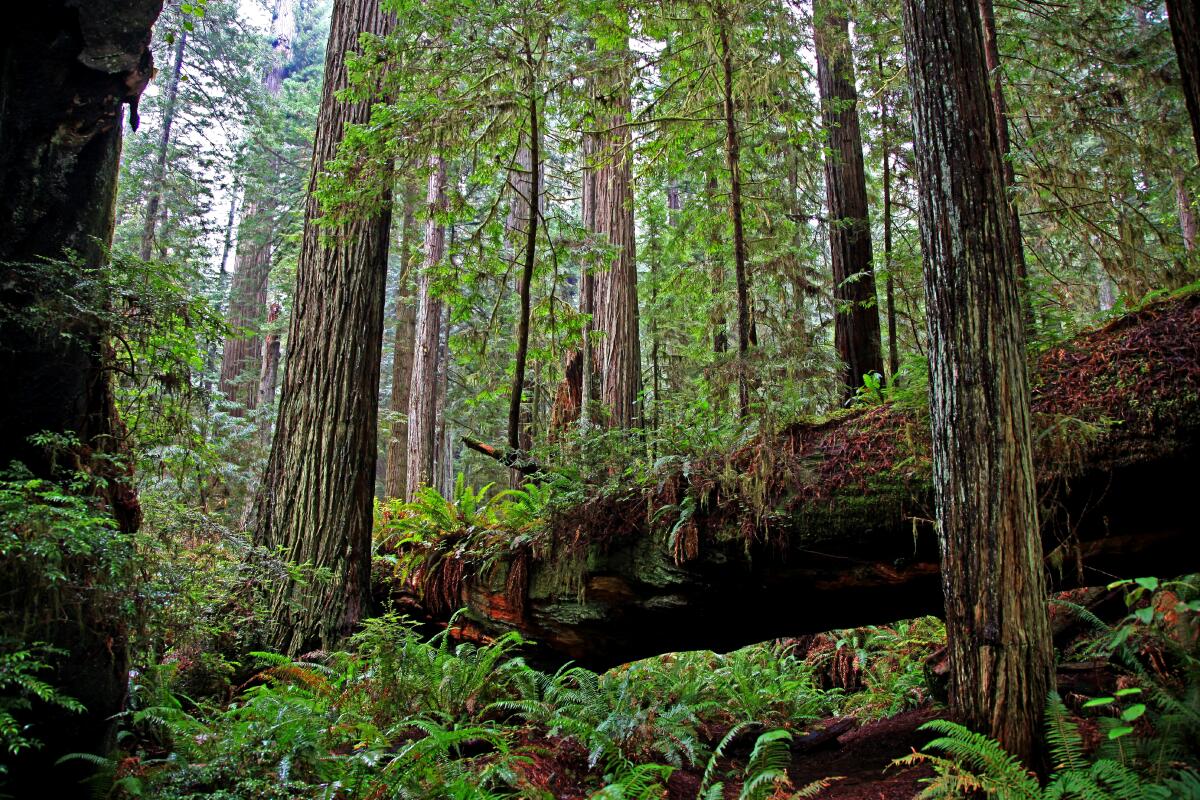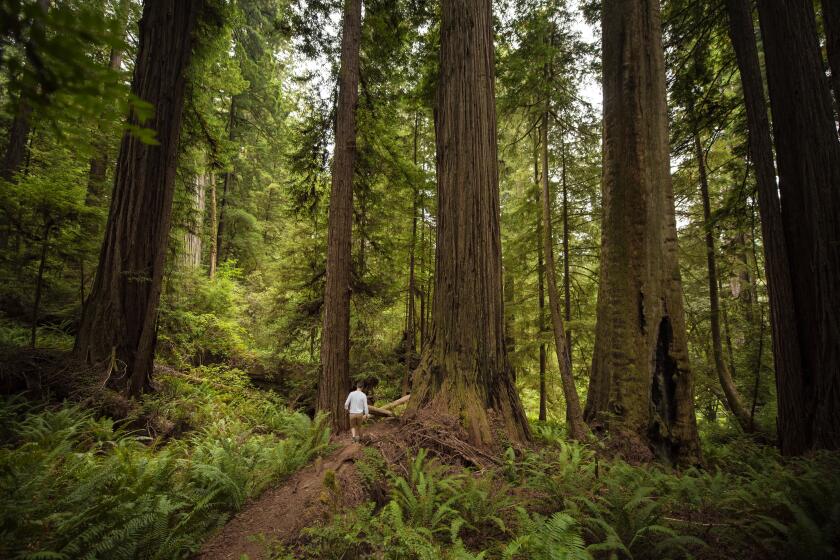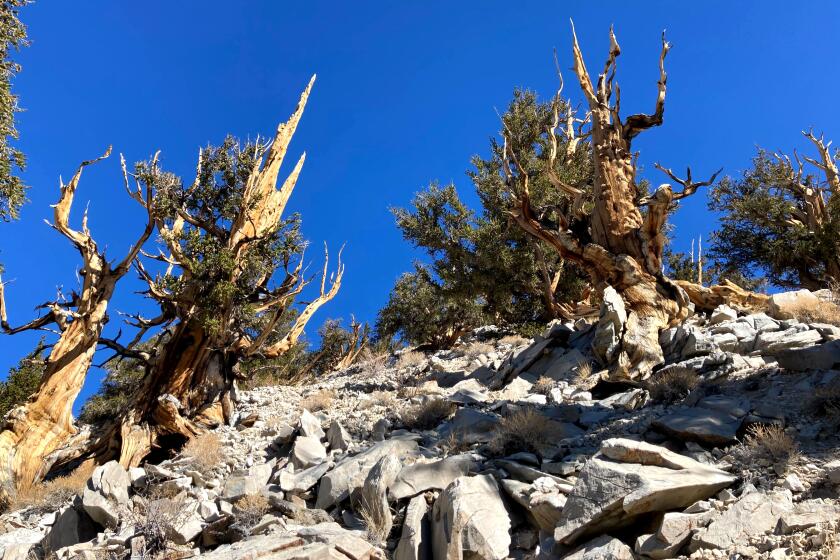Op-Ed: Why banning hikes to the world’s tallest tree will never work

- Share via
The National Park Service is trying to preserve the world’s tallest tree by banning hikes to it. But this approach will never completely work since the location of the 380-foot redwood is an open secret. Instagrammers and the Guinness Book of World Records have made sure of that.
Still, the gargantuan tree — a coast redwood (Sequoia sempervirens) that was technically “discovered” by two amateur naturalists in 2006 — is officially off-limits to visitors even though it is only a short distance off a main trail. Bushwhack your way to it in California’s Redwood National Park and you could face six months in jail and a $5,000 fine, the park service announced early this month.
Potential endangerment and a location that’s officially confidential? Adding risk to the equation could make gazing up at the king of the redwoods that much more enticing to hikers who have put it on their bucket list.
Restrictions alone aren’t the answer. The park service should also make a point of educating the public about Hyperion, the world’s tallest tree at this moment, and the greater redwood forest — and then maybe cross their fingers and hope that people will truly listen.
California’s Redwood National Park officials have made the 380-foot redwood off-limits. Visitors caught near it could face six months in jail and a $5,000 fine.
For example, being declared the world’s tallest tree in a redwood forest is a little like temporarily winning a glacially slow race. Hyperion is estimated to be between 600 and 800 years old while the average age of its coast redwood siblings ranges from at least 800 to 1,500 years. It isn’t even the oldest — that would be a nearby redwood named Gaia that is at least 3,500 years old.
In addition, the California redwood holding the title of “world’s tallest” has changed multiple times in my lifetime, partly because new titleholders emerged as the forest continued to be surveyed. And the title will inevitably be handed off again.
Coast redwoods reach their maximum height by the time they are 300 to 500 years old, so a younger redwood still experiencing vertical growth will likely take the “world’s tallest” crown from Hyperion within seven years. Over the course of their very long lives, the trees often lose sections of their crown due to wind and lightning, which also could cost Hyperion its record.
The habitat surrounding Hyperion has been devastated because no trail leads to it. Still, it would be pointless to devote the millions of dollars necessary to build a trail to Hyperion — named after the Greek Titan god of heavenly light — when at any moment its reign could be over.
Besides, the most important coast redwoods to the forest’s ecology are not the tall ones — they are the trees that have been able to get old enough and large enough to create complex canopy structures by cloning themselves hundreds of feet off the ground, creating garden labyrinths in the sky.
Sadly, humans have significantly damaged most of the world’s forests, and almost no virgin forests are left. By the 1960s, industrial logging had removed 90% of the old-growth redwoods. Today, only less than 5% of them remain.
When the park was established by an act of Congress and signed into law by President Lyndon B. Johnson on Oct. 2, 1968, an initial 58,000 acres of redwoods were placed in the care of the National Park Service. Another 48,000 acres were added in 1978.
As first lady, Lady Bird Johnson played a crucial role in getting the park created, and a redwood grove was dedicated to her in 1969. At the ceremony she said, “Conservation is indeed a bipartisan business because all of us have the same stake in this magnificent continent.”
That’s the point the National Park Service and other preservationists need to make over and over. We all have an interest in protecting nature’s bounty for future generations. This especially applies to redwood trees, which grow on the coast from Big Sur up to the Oregon border and nowhere else.
To preserve the redwoods, and keep visitors away from Hyperion, the park service should expand its educational efforts. This could include placing interpretive rangers in the field who can educate and keep watch over park guests.
I (probably) found Methuselah. That it may no longer be the world’s oldest known tree does not damp my awe for the majestic bristlecone pines.
A permitting process could be set up to require guides like me to purchase additional permits and to abide by additional restrictions when park visitors want to see areas that could be harmed by human trampling. Income from the permits could be used to fund education efforts and the permit program itself.
The chief problem in hiking to Hyperion is that there is no main route to the tree, and most visitors are just guessing how to find it. Instead of forbidding viewing, the park could allow visitors to hike to Hyperion if they were accompanied by a certified and permitted guide.
Populating the park with such guides also might encourage the public to treat this national treasure with greater respect. They could also point out the dozens of easily accessible — and significant — coast redwoods, such as an albino redwood known as the Spirit that is just feet from the park’s visitor center.
When people ask me to take them to Hyperion, my initial response is invariably a lengthy “ughhh,” quickly followed by a detailed explanation of the wonder all around them. I engage with them about forest history, and take them on a trail where they can easily see gigantic old-growth redwoods and experience the glory of the complex canopy life. After that, I’ve never had a visitor who still wanted to see Hyperion. Not a one.
Justin Legge is a naturalist and forest therapy guide in Humboldt County based at the Benbow Historic Inn.
More to Read
A cure for the common opinion
Get thought-provoking perspectives with our weekly newsletter.
You may occasionally receive promotional content from the Los Angeles Times.











